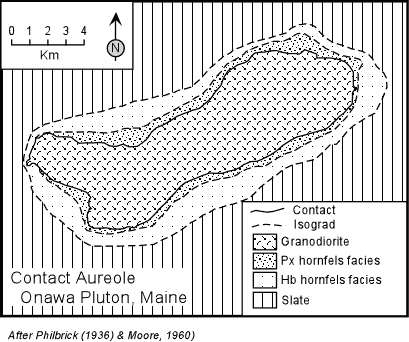
| EENS 2120 |
Petrology |
| Prof. Stephen A. Nelson |
Tulane University |
|
Contact Metamorphism |
|
| As discussed previously, contact metamorphism occurs as a result of a high geothermal
gradient produced locally around intruding magma. Contact metamorphism is usually
restricted to relatively shallow depths (low pressure) in the Earth because it is only at
shallow depths where there will be a large contrast in temperature between the intruding
magma and the surrounding country rock. Also, since intrusion of magma does not
usually involve high differential stress, contact metamorphic rocks do not often show
foliation. Instead, the common rocks types produced are fine grained idioblastic or
hypidioblastic rocks called hornfels. The area surrounding an igneous intrusion that has
been metamorphosed as a result of the heat released by the magma is called a contact
aureole. We will here first discuss contact aureoles, then look at the facies
produced by contact metamorphism.
Contact Aureoles Within a contact metamorphic aureole the grade of metamorphism increases toward the contact with the igneous intrusion. |
| An example of a contact aureole surrounding the Onawa Pluton in Maine is shown here. The granodiorite pluton was intruded into slates produced by a prior regional metamorphic event. The aureole is a zone ranging in width from about 0.5 to 2.5 km around the intrusion. Two zones representing different contact metamorphic facies are seen within the aureole. The outer zone contains metapelites in the Hornblende Hornfels Facies, and the zone adjacent to the pluton contains metapelites in the Pyroxene Hornfels Facies. The zones are marked by an isograd, which represents a surface along which the grade of metamorphism is equal. |  |
|
Solutions to the heat equation given above are complicated because most
the terms in the equation are functions of temperature, time, and position.
Solutions for a simple case are shown below. |
| In this simple case a basaltic dike is assumed to have intruded at temperature of 1100oC, into dry country rock at a temperature of 0oC. The width of dike is assumed to be 1000 m, and the latent heat of crystallization is assumed to be released between 1100o and 800o. Solidification of the intrusion is thus complete at 800o, after 10,300 years. Note how the temperature of the country rock near the contact reaches a maximum of about 600o after about 1600 years, and how the temperature in the country rock at distances greater than about 700 m from the center of the dike continues to rise, while temperatures near the contact drops. |
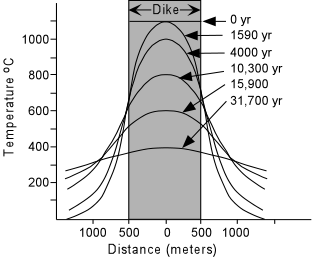 |
| The model above assumes that all heat moves by conduction. If the country rock is saturated with water or the pluton expels water, and if the country rock is permeable, then the heat will move into the country rock by convection. Water will be heated near the contact and carry heat outward and away where it will eventually cool to return to the contact to carry more heat away. |
| To show these effects, a model was developed for a diabase sill 700 m thick, intruded under 350 m of cover into both dry and wet country rock. The results show that the temperature gradient developed in the country rock will be higher under dry country rock conditions, and the actual temperature attained in the country rock at any position will be slightly less under wet conditions than under dry conditions. Thus, the size of the aureole will be smaller if the heat is removed and distributed by convection. |
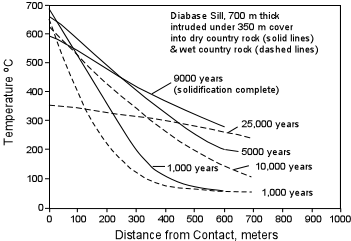 |
The facies of contact metamorphism progress in temperature at relatively low pressure from the Albite-Epidote Hornfels Facies to the Hornblende Hornfels Facies, to the Pyroxene Hornfels Facies. Xenoliths picked up by the magma may be metamorphosed to the Sanidinite Facies, but such rocks are relatively rare. In this lecture we will look at the mineral assemblages that develop in these contact metamorphic facies. Albite - Epidote Hornfels Facies |
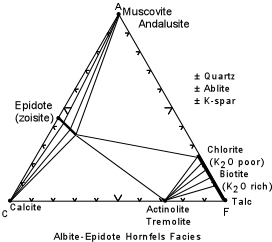 |
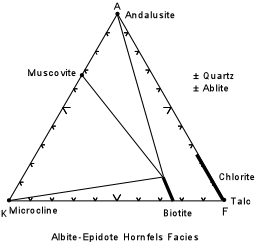 |
Pelitic rocks will be characterized by an assemblage of
Quartzo-feldspathic rocks will be characterized by an assemblage of
|
|
Basic rocks will contain
Calcareous rocks will consist of
|
| Hornblende-Hornfels Facies |
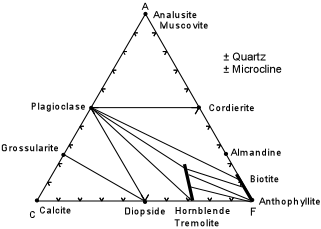 |
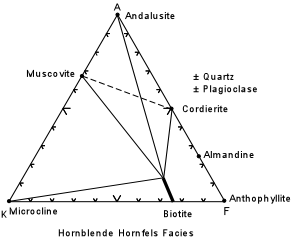 |
Pelitic rocks will be characterized by an assemblage of
Quartzo-feldspathic rocks will be characterized by an assemblage of
Basic rocks will likely contain
Calcareous rocks will consist of
|
Pyroxene-Hornfels Facies |
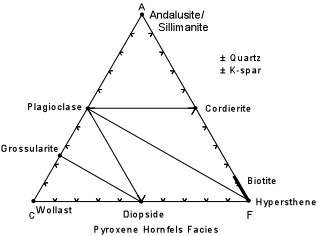 |
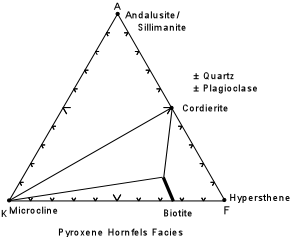 |
Pelitic rocks will be characterized by an assemblage of
Quartzo-feldspathic rocks will be characterized by an assemblage of
Basic rocks will likely contain
Calcareous rocks will consist of
|
| Sanidinite Facies The sanidinite facies is relatively rare in contact metamorphic aureoles, although it is somewhat more common in rocks found as xenoliths in igneous rocks. It represents the highest conditions of temperature. The facies is characterized by the absence of hydrous minerals, particularly micas.
|
Skarns Sometimes when a siliceous magma intrudes carbonate rocks like limestone and dolostone, significant chemical exchange (metasomatism) takes place between the magma and the carbonate rock. Such a metasomatized rock is refered to as skarn. An excellent example of a skarn occurs in the Crestmore quarry near San Diego, California. |
| Here, quartz monzonite intruded an Mg-rich limestone. Metamorphism and metasomatism produced four zones near the contact three ranging in size from 3 cm to 15 m in width. The outer zone consists of calcite marble or calcite - brucite [MgOH2] marble, showing little metasomatism. | 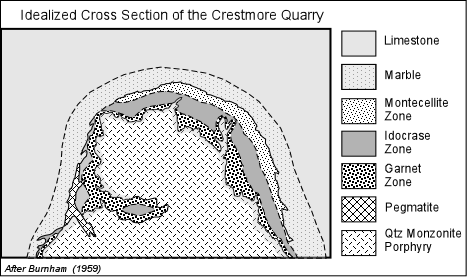 |
| Closer to the contact is the montecellite zone. This zone consists of calcite,
montecellite [Ca(Mg,Fe)SiO4] and one or more of the minerals clinohumite
[Mg(OH,F)2.4Mg2SiO4], forsterite, mellilite,
spurrite [2Ca2SiO4.CaCO3], tilleyite [Ca3Si2O7.2CaCO3],
and merwinite [Ca3MgSi2O8]
Interior to the montecellite zone is the idocrase zone, consisting of idocrase [Ca19(Al,Fe)10(Mg,Fe)3Si18O68(OH,F)10] in association with calcite, diopside, wollastonite, phlogopite (Mg-rich biotite), montecellite, and xanthophyllite [Ca2(Mg,Fe)4.6Al6.9Si2.5O20(OH)4]. Next to the contact is the garnet zone consisting of grossularite garnet, diopside, wollastonite, and miner calcite and quartz. A thin zone along the contact shows evidence of assimilation of the limestone by the magma. The ratio of Si to Ca and the concentration of Al all increase toward the contact, indicating that the limestone received these components from the magma. |
Examples of questions on this material that could be asked on an exam
|